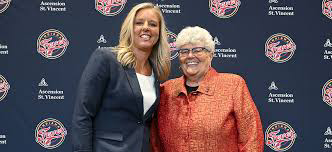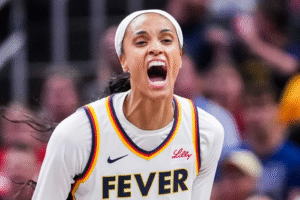
Phoenix Mercury Make Roster Change: Waive Guard Kiana Williams to Add Veteran DeWanna Bonner
Earlier this week, the Phoenix Mercury announced a significant roster adjustment, releasing guard Kiana Williams as they finalized terms for acquiring long-time WNBA forward DeWanna Bonner. Though the move was anticipated—given that WNBA teams are capped at 12 players—it has nonetheless sparked discussion around team strategy, player development, and the ongoing impact of roster restrictions.

1. The Decision to Part Ways with Williams
Kiana Williams, a second-year guard, found herself on the outside of the Mercury’s revamped roster. Brought in before the season began, Williams appeared in limited minutes across Phoenix’s backcourt rotation. Statistically, she posted averages of 5.3 points, 1.3 boards, and 1.0 assist per outing, reflecting a role focused on depth and support behind established guards Kahleah Copper, Sami Whitcomb, and Monique Akoa-Makani.
Although not a primary option, Williams provided the Mercury with a reliable bench presence. Her contributions were consistent, if unspectacular—a fairly common profile for role players in their initial seasons. While she showed glimpses of potential and carved out situational usefulness, the timing and importance of this roster decision were ultimately dictated by the league’s strict 12-player roster limit.
In explaining her release, Williams exemplified professionalism. She acknowledged the grace of being part of the team and expressed gratitude for the opportunity—stating simply, “I’m just grateful for the opportunity.” The response underscored her maturity and adaptability in facing the realities of professional sport.
2. Enter DeWanna Bonner: Experience Meets Opportunity
Following Williams’s release, the Mercury officially signed DeWanna Bonner, a seasoned forward with six WNBA All-Star nods to her credit. Bonner had most recently played for the Connecticut Sun before joining the Indiana Fever during the 2025 season. Over an enduring 16-year career, she has averaged 14.8 points per game, and Phoenix acquired her specifically to bring scoring strength and playoff composure into their lineup.
Bonner’s numbers reflect a reliable all-around performer: she scores efficiently, rebounds judiciously, and brings veteran leadership. Despite the Mercury’s potent mix of scorers and defenders, the team clearly sees in her the capacity to fill key minutes, boost production, and bolster their playoff rotation as the season progresses.
3. Bonner’s Midseason Journey: From Connecticut to Indiana
DeWanna Bonner’s résumé includes standout stops, most notably her time with the Connecticut Sun, where she became a core contributor. In 2025, she transitioned to the Indiana Fever, aligning with star guard Caitlin Clark. Yet, her tenure in Indiana lasted only nine games, during which she averaged 21.3 minutes, scoring 7.1 points, pulling down 3.8 rebounds, and adding 1.6 assists and 1.1 steals per matchup.
Although these contributions were valuable, Bonner appeared less than wholly satisfied with her sixth-player role—reflective of a desire to leverage her talents more prominently. Phoenix stepped into that narrative, presentingBonner with a chance to jump into a higher-usage role, with more offensive responsibility and team reliance.
4. Balancing the Scale: Experience vs. Development
The release of Kiana Williams and signing of DeWanna Bonner illustrates a recurrent theme in the WNBA: retirees must often choose between cultivating young bench players and integrating proven veterans. With only 12 roster spots, balancing developmental trajectories with immediate performance needs creates unique pressure.
For the Mercury, contending in a competitive Western Conference, the scales tipped in favor of playoff readiness. At the same time, Williams demonstrated the kind of resilience and attitude that suggests she’ll remain a name to watch. Her measurable impact wasn’t earth-shattering, but her presence was steady—qualities that rarely go unnoticed in a small league.
5. Roster Restrictions, Talent Pressure & Strategic Shifts
Beyond the individual fates of Williams and Bonner, this move highlights structural tension within the WNBA. The 12-player limit, even within a league with fewer teams but top-tier talent, forces squads to make tough choices. Executives must continually decide between:
Prospects with upside—like Williams, whose early promise may pay dividends,
Solid players who reliably produce—like Bonner, with her long history of performance,
And the occasional veteran seeking the right setting to finish their career strong.
As the talent pool deepens—with more players joining from college, overseas stints bringing development, and increased global attention—the competition for roster spots intensifies.
6. Kiana Williams: From Stanford Standout to Mercury Role Player
Williams’s journey adds another layer. A standout guard at Stanford, she carried considerable expectations through her collegiate career. Drafted by the Seattle Storm in 2021, she began her professional path with limited minutes. A brief stint with the Connecticut Sun in 2022 followed before landing in Phoenix this year.
Thus far, Williams has shown promise but never quite broken through into a primary role. Her release might signify more about the depth behind her than any shortcomings. With her collegiate accolades and glimpses of pro-day potential, there remains a strong possibility she’ll find a new opportunity elsewhere. Her composure—expressed in gracious post-waiver statements—only adds to her chances of re-emergence.
7. DeWanna Bonner’s Fit in Phoenix: What She Brings
Bonner’s value doesn’t stop at scoring numbers. Across her 16-year career, she has offered:
Veteran leadership—mentoring young players,
Physical toughness—helping anchor defensive sets and crash boards,
Clutch production—experienced in big-game scenarios,
Positional versatility—able to play across forward spots and stretch the floor.
In Phoenix, where the Mercury are aiming for a deep playoff run, Bonner fills several gaps. Kahleah Copper, Sami Whitcomb, and Akoa-Makani form a strong guard presence, but length and scoring at the forward spots add balance. Bonner’s presence could alleviate matchup concerns, provide depth late in games, or allow for different lineups in high-stakes moments.
8. The Immediate Impact on Team Dynamics
On paper, Bonner’s role seems clear: to supply Phoenix with a potent scoring option alongside Copper and Whitcomb. But her day-to-day influence is equally promising. Her experience and established career could have ripple effects on:
Team culture—adding grit, cohesion, and focused guidance,
Player development—helping younger athletes adjust to the pro grind,
Playing-time allocation—allowing coaches to navigate injuries or fatigue more confidently.
Her arrival, therefore, represents not just an injection of points, but a holistic boost to team identity as the Mercury pursue postseason success.
9. Implications for the Indiana Fever
Bonner’s departure from the Fever after only nine games—despite a connection with Caitlin Clark—suggests unmet expectations in role alignment. She recorded modest stats and appeared to seek greater responsibility. For Indiana, her exit may offer more freedom to build a long-term rotation around Clark and other developing talents. While they lose an experienced forward, the roster spot can now be redirected.
10. Broader Consequences: Roster Toughness & WNBA Growth
This transaction offers a lens into multiple WNBA dynamics:
1. Talent saturation – With more players capable of high-level play, the selection margin narrows.
2. Roster limits stress strategy – Teams must regularly assess whether to invest in youth or proven assets.
3. Veteran landing spots shrink – Even decorated players like Bonner find their worth continually reevaluated.
4. Professional temperament earns respect – Williams’s response shows the mindset teams reward.
In sum, this move underscores a league at full competitive capacity—where experience and upside wrestle for finite roles.
11. Aftermath for Williams & Bonner
Kiana Williams must now navigate her next steps. While Phoenix opted for veteran savvy, Williams has enough pedigree and maturity to attract interest:
From teams with injuries needing wing guard depth,
From overseas clubs offering playing time and continued development,
From future training camps aiming to build flexible rotational options.
Her reaction—the gratitude, grace, and professionalism—puts her in a solid position for opportunities.
DeWanna Bonner, meanwhile, walks into a more clearly defined role. She lands on a competitive team, seeking her experience and firepower more than a welfare bench slot. A successful integration could extend Phoenix’s playoff window and justify taking a seasoned contributor to fill a championship push.
12. The Trade-off Equation
This move distills what many observers have noted as WNBA roster reality: each strategic step invites trade-offs.
Immediate reinforcement vs. future promise – Bonner’s impact is known; Williams is a project with upside.
Experienced minutes vs. developmental floor time – A win-now mentality matched by Phoenix’s adding a veteran.
Depth laced with street smarts vs. athletic upside with risk – Playing time, versatility, understanding tactics—Bonner offers poise in contrast to Williams’s athleticism and room to mature.
13. What’s Next for Phoenix
Phoenix now heads into the mid-season stretch with renewed depth and an expanded skill set among its frontcourt options. Questions to watch:
How Bonner fits the rotation—does she slot as a starter or sixth-woman?
Court chemistry adjustments—balancing her game with Copper and Whitcomb.
Team balance—ensuring defensive integrity and offensive spacing amid lineup shifts.
Assuming healthy periods, the Mercury look positioned to stay competitive in a deep playoff push.
14. Broader League Context
This move also resonates in the wider WNBA environment:
Veterans on the move – Bonner, now with Phoenix, mirrors other experienced players shifting to contenders mid-season.
Evolving roster strategies – Small rosters necessitate ongoing recalculations; teams like Phoenix must constantly weigh present needs against future potential.
Opportunities for wings – Talented wings like Williams should monitor waiver wires, overseas options, and training camps, ready to fill gaps.
15. Final Thoughts
The Phoenix Mercury’s decision to waive Kiana Williams in favor of DeWanna Bonner embodies a blend of strategy and necessity:
It frees a valuable roster slot under league constraints,
Elevates veteran presence and scoring capacity,
Underscores both resilience and sacrifice in player development tracks.
For Williams, the path ahead looks less halted than rerouted—her talent and demeanor suggest new opportunities will emerge. For Bonner, it’s an invitation to reinvigorate her career with a team poised for contention. And for the Mercury, it’s a calculated move to sharpen their roster as they aim for sustained playoff impact.
Ultimately, this transaction shines a spotlight on the ever-tight margins of WNBA rosters, where one move can reverberate through careers, team seasons, and league-wide competitive balance.
Leave a Reply